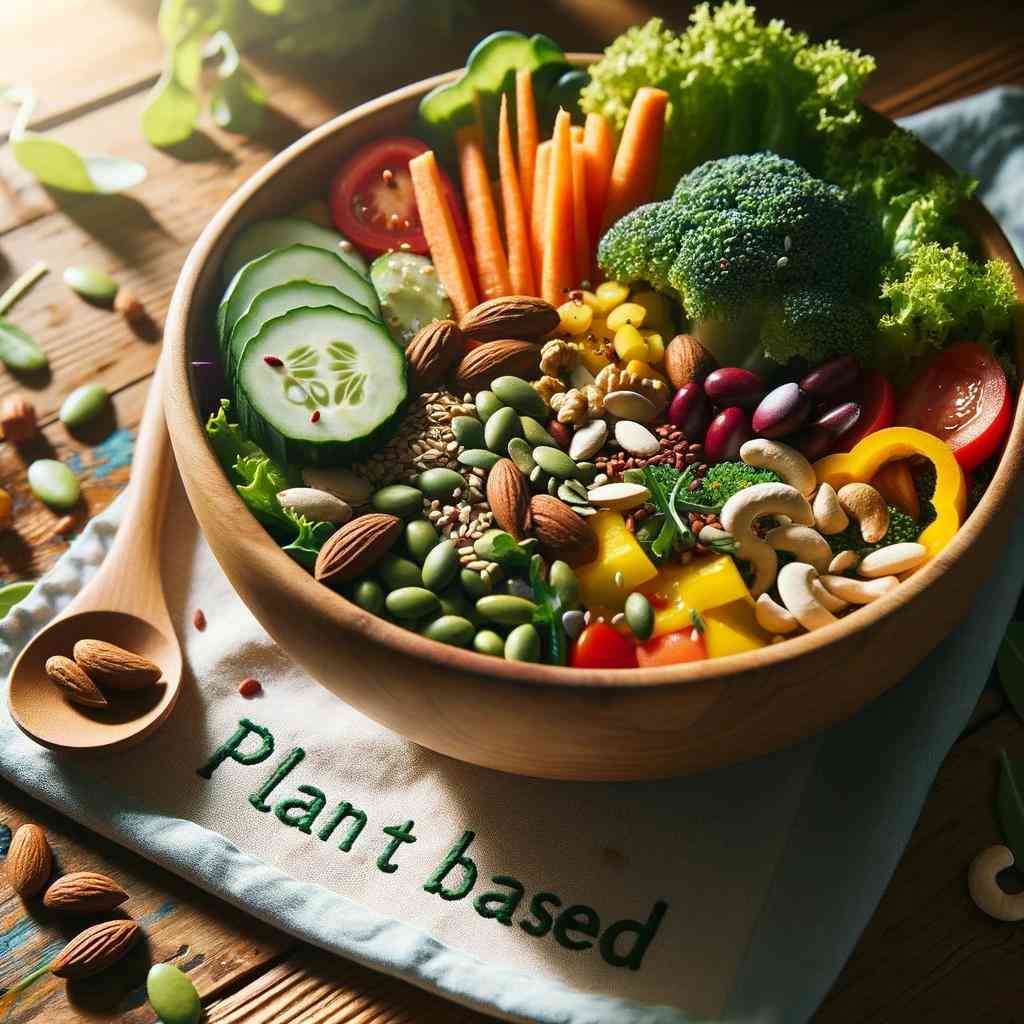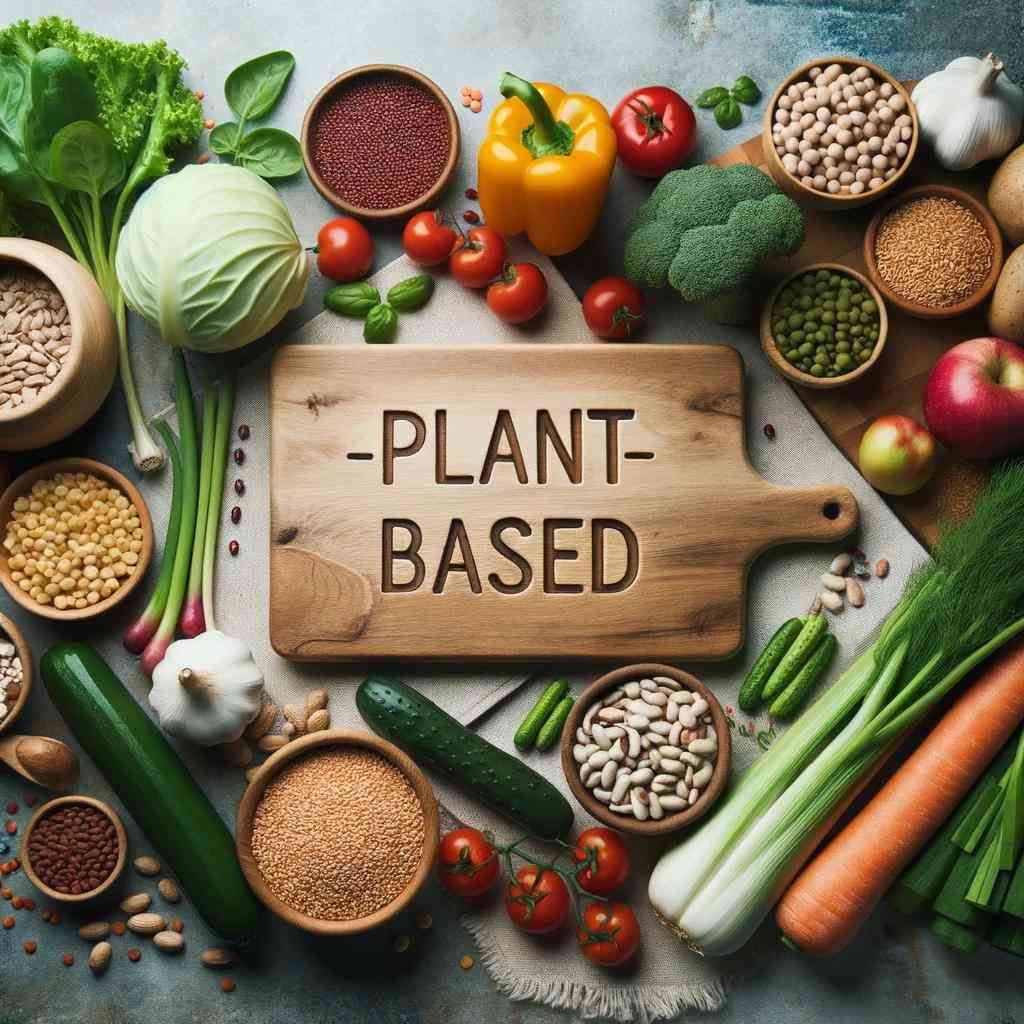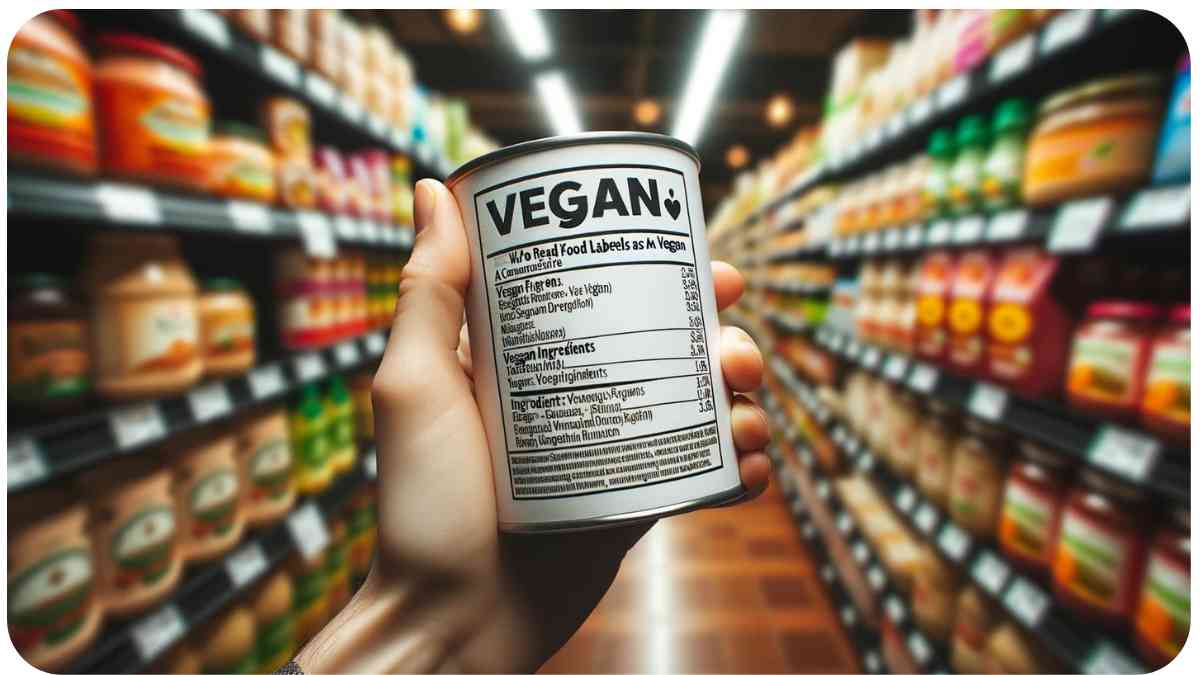Welcome to our comprehensive guide on how to read food labels as a vegan. If you’re a seasoned vegan or just starting on your plant-based journey, understanding food labels is crucial for making informed choices and ensuring that the products you consume align with your ethical and dietary preferences.
In this guide, we will delve deep into the world of food labels, decoding the language and symbols to help you confidently select vegan-friendly products.
| Key Takeaways |
|---|
| 1. Reading food labels is crucial for vegans to ensure their diet aligns with their values and dietary preferences. |
| 2. Understand vegan-friendly label claims like “Certified Vegan” and “Plant-Based” to make informed choices. |
| 3. Scrutinize ingredient lists to identify common non-vegan ingredients and hidden animal-derived additives. |
| 4. Pay attention to key nutrients like protein, calcium, iron, vitamin B12, and omega-3 fatty acids when reviewing nutritional information. |
| 5. Be aware of allergen warnings and potential cross-contamination risks. |
| 6. Check date codes and packaging materials for freshness and sustainability. |
| 7. Look for trustworthy third-party certifications like “Certified Vegan” and “Non-GMO Project Verified.” |
| 8. Support local and ethical practices by considering the country of origin. |
| 9. Use personal tips for efficient label reading, such as taking your time and utilizing apps. |
| 10. Real-life examples can help you apply label-reading skills effectively. |
2. Why Reading Food Labels Matters for Vegans
As a vegan, you’ve made a conscious decision to avoid animal-derived ingredients and products. Reading food labels ensures that you remain true to your commitment. But why is it so important?
Understanding food labels as a vegan is crucial for making informed choices. In our article on veganism’s future, we explore why this lifestyle is gaining momentum and how it relates to labeling.
Certified Vegan
When it comes to vegan-friendly label claims, one of the most reliable certifications is the “Certified Vegan” logo. This seal indicates that the product has been rigorously evaluated and is free from animal-derived ingredients or by-products.
Plant-Based

While “plant-based” is a term often associated with veganism, it’s important to scrutinize products claiming to be plant-based. Sometimes, they may contain trace amounts of animal ingredients. Always check the ingredient list for clarity.
Dairy-Free
Dairy-free products are typically suitable for vegans. However, check for other non-vegan additives like gelatin or certain colorings.
Egg-Free
Egg-free labels are a good sign for vegans, but still, scan the ingredient list for hidden animal ingredients or egg substitutes.
When deciphering food labels, consider the environmental impact of your choices. Discover how a vegan diet can positively affect the planet in our eye-opening article.
3. Understanding Vegan-Friendly Label Claims
Food labels often contain claims that can be misleading or confusing for vegans. Let’s take a closer look at some of these claims.
Scanning the Ingredient List
The ingredient list is a goldmine of information for vegans. It provides a detailed breakdown of what’s inside the product. Here are some key points to consider:
Common Non-Vegan Ingredients
- Gelatin
- Casein (a milk protein)
- Carmine (a red pigment from insects)
- Lard
- Whey (a by-product of cheese)
Unveil the science behind the health benefits of a vegan diet. Learn how plant-based nutrition can impact your well-being in our comprehensive guide.
Hidden Animal-Derived Additives
Some ingredients may not sound explicitly animal-derived but are, in fact, derived from animals. Examples include:
- Rennet (used in cheese-making)
- L-cysteine (often sourced from poultry feathers)
- Isinglass (derived from fish bladders, used in wine and beer production)
4. Scanning the Ingredient List

When scanning the ingredient list, keep an eye out for these common additives that might not be vegan-friendly:
| Additive Name | Source | Common Uses |
| Gelatin | Animal collagen | Gummy candies, marshmallows |
| Carmine | Cochineal insects | Red food coloring |
| Casein | Milk protein | Non-dairy creamers, cheese |
| Lard | Pig fat | Baking, frying |
| Whey | Milk by-product | Protein supplements, snacks |
It’s essential to be meticulous when reviewing ingredient lists to ensure you don’t inadvertently consume animal-derived ingredients.
Navigating social situations can be challenging for vegans. Explore practical tips in our article on dealing with social situations to maintain your vegan lifestyle gracefully
5. Nutritional Information
Vegans need to pay special attention to the nutritional information on food labels to ensure they meet their dietary needs. Here are the key nutrients to focus on:
Key Nutrients for Vegans
- Protein
- Calcium
- Iron
- Vitamin B12
- Omega-3 Fatty Acids
Evaluating Macronutrients
When assessing nutritional information, look at the following macronutrients per serving:
- Protein
- Carbohydrates
- Fats
- Dietary Fiber
Understanding these values will help you make informed choices that align with your dietary goals.
Let’s break down the macronutrients and their significance for vegans:
| Nutrient | Importance for Vegans | Sources |
| Protein | Essential for tissue repair and growth. | Legumes, tofu, tempeh, quinoa |
| Calcium | Crucial for bone health. | Fortified plant milks, kale, figs |
| Iron | Needed for oxygen transport in the blood. | Lentils, spinach, pumpkin seeds |
| Vitamin B12 | Essential for nerve function and energy. | Fortified foods, supplements |
| Omega-3 Fatty Acids | Beneficial for heart and brain health. | Flaxseeds, walnuts, chia seeds |
Understanding these nutrients will help you maintain a balanced and healthy vegan diet.
Planning a trip? Ensure you can find vegan options with ease. Read our guide on finding vegan-friendly restaurants and accommodation for a stress-free journey
6. Allergen Warnings
Apart from checking for animal-derived ingredients, vegans should also be aware of potential allergens in food products. Here are common allergens to watch out for:
| Common Allergens | Potential Sources |
| Milk | Dairy products, baked goods |
| Eggs | Baked goods, dressings, mayonnaise |
| Nuts | Snacks, desserts, nut butter |
| Soy | Soy-based products, processed foods |
| Wheat | Bread, pasta, cereal |
Always look for allergen warnings on the label to avoid any unpleasant surprises.
7. Date Codes and Expiry Dates
Understanding date codes and expiry dates is crucial for ensuring the freshness and safety of your vegan products. Here’s what to look for:
Shelf Life and Freshness
- “Best Before”: This date indicates when the product is at its best quality but is still safe to consume after.
- “Use By”: This date is crucial for perishable items. Consuming the product after this date can pose health risks.
Properly storing products and respecting these dates can help you avoid food waste.
8. Packaging Materials
Vegans often care about sustainability. Examining packaging materials is another step toward aligning your choices with your values.
Sustainable and Eco-Friendly Packaging
Look for labels indicating recycled materials, biodegradable packaging, or products with minimal packaging. Supporting eco-conscious brands is a win-win for the planet and your vegan lifestyle.
9. GMO Labeling
If you’re concerned about genetically modified organisms (GMOs) in your food, you can identify them by checking for GMO labeling.
Identifying Genetically Modified Ingredients
- Look for labels like “Non-GMO Project Verified” or “USDA Organic,” which generally indicate GMO-free products.
Understanding GMO labeling empowers you to make choices in line with your preferences.
10. Country of Origin

Knowing the country of origin of a product can be important for various reasons, including supporting local and ethical practices.
Supporting Local and Ethical Practices
By choosing products from your region or those with transparent supply chains, you can contribute to local economies and encourage ethical production methods. Look for labels indicating the product’s origin.
11. Third-Party Certifications
To ensure the authenticity of vegan claims and the quality of products, third-party certifications are invaluable.
Trustworthy Certifications for Vegans
Here are some well-recognized certifications to watch for:
- Certified Vegan: As mentioned earlier, this certification guarantees that a product is vegan-friendly.
- USDA Organic: Signifies that the product meets strict organic standards.
- Non-GMO Project Verified: Ensures that the product is free from genetically modified organisms.
Relying on these certifications can save you time and effort in label reading.
12. Cross-Contamination Risks
Cross-contamination can occur in facilities that handle both animal and plant-based products. Vegans should be vigilant to prevent accidental animal product consumption.
Preventing Accidental Animal Product Contamination
- Look for “May contain” or “Processed in a facility that handles” warnings. These indicate a potential risk of cross-contamination.
- Contact the manufacturer: If unsure, don’t hesitate to reach out to the manufacturer for clarification.
13. Personal Tips for Efficient Label Reading
As a vegan, my years of experience have taught me some valuable tips for efficient label reading:
- Take your time: Rushing through labels can lead to missed details.
- Use apps: There are apps that can scan barcodes and provide instant vegan information.
- Keep a list: Maintain a list of go-to vegan brands and products to simplify your shopping.
14. Real-Life Examples
Let’s put our label-reading skills to the test with real-life examples. We’ll analyze food labels from popular brands to demonstrate how to make informed choices.
Example 1: Vegan Snack Bars
| Ingredient | Source | Vegan-Friendly? |
| Organic oats | Plant-based | Yes |
| Almonds | Plant-based | Yes |
| Organic honey | Bee-derived | No |
| Dark chocolate chips | Plant-based | Yes |
| Natural flavors | Varies | Check with brand |
In this example, the presence of honey makes these bars non-vegan.
Example 2: Vegan Frozen Pizza
| Ingredient | Source | Vegan-Friendly? |
| Whole wheat crust | Plant-based | Yes |
| Tomato sauce | Plant-based | Yes |
| Vegan cheese | Plant-based | Yes |
| Spinach | Plant-based | Yes |
| Artificial flavors | Varies | Check with brand |
In this case, all ingredients are vegan, making the pizza a suitable choice for vegans.
Conclusion
In conclusion, reading food labels as a vegan is an essential skill that ensures your diet aligns with your values and meets your nutritional needs.
By understanding vegan-friendly label claims, scrutinizing ingredient lists, and being aware of potential allergens and other factors, you can make informed choices that support your vegan lifestyle. Remember, practice makes perfect, so keep honing your label-reading skills, and enjoy your journey toward a more compassionate and sustainable way of eating.
Further Reading
For more in-depth information on reading food labels as a vegan, consider exploring the following resources:
- Sarah’s Vegan Guide
- Discover Sarah’s insights into deciphering food labels as a vegan, with practical tips and real-world examples.
- Vegan Food and Living
- Dive into a comprehensive guide on reading food labels tailored for vegans, featuring expert advice and helpful strategies.
- LinkedIn Article by Jessica Bedford
- Jessica Bedford shares her perspective on navigating food labels as a vegan, providing valuable insights and considerations.
FAQs
What is the significance of reading food labels as a vegan?
- A: Reading food labels helps vegans ensure that the products they consume align with their ethical and dietary preferences, avoiding animal-derived ingredients.
How can I identify hidden animal-derived additives on food labels?
To spot hidden animal-derived additives, carefully review the ingredient list and be aware of names like gelatin, casein, and carmine.
What key nutrients should vegans focus on when reading nutritional information?
Vegans should pay attention to protein, calcium, iron, vitamin B12, and omega-3 fatty acids when evaluating nutritional information on food labels.
Are all organic products automatically suitable for vegans?
No, organic products are not necessarily vegan. While they follow certain farming practices, you should still check the ingredient list for confirmation.
How can I avoid cross-contamination risks mentioned in food labels?
To prevent accidental animal product contamination, look for warnings like “May contain” or “Processed in a facility that handles,” and contact the manufacturer if unsure.

Hi! My name is Hellen James, and I’m a vegan lifestyle enthusiast. I’ve been living the vegan lifestyle for over 10 years now, and it’s been one of the best decisions I’ve ever made. The food is amazing, the community is incredible, and there’s no way I could go back after experiencing all this firsthand.


